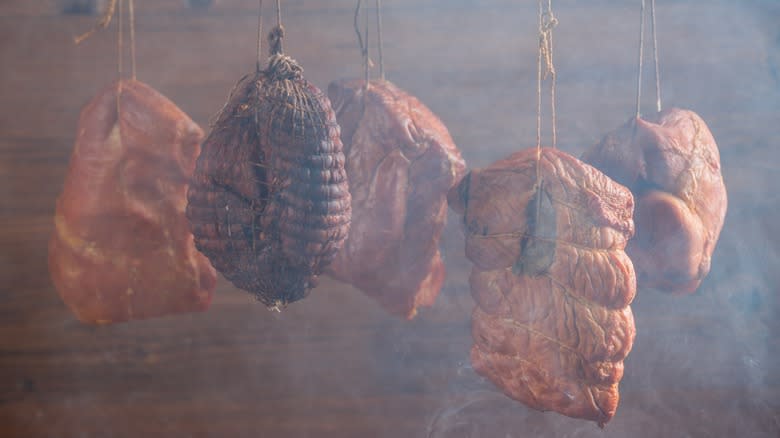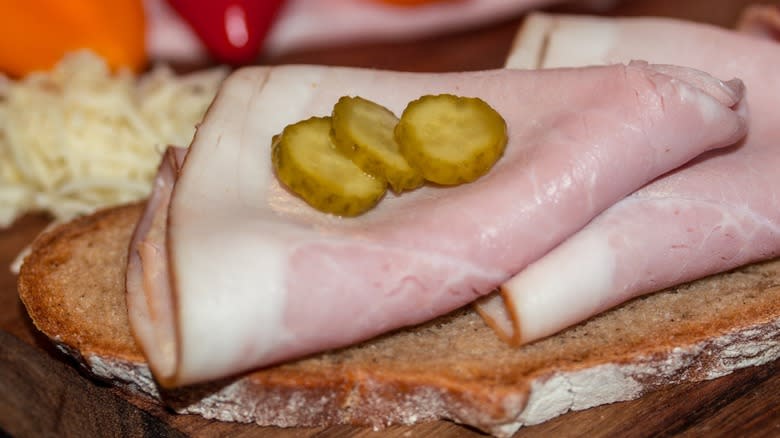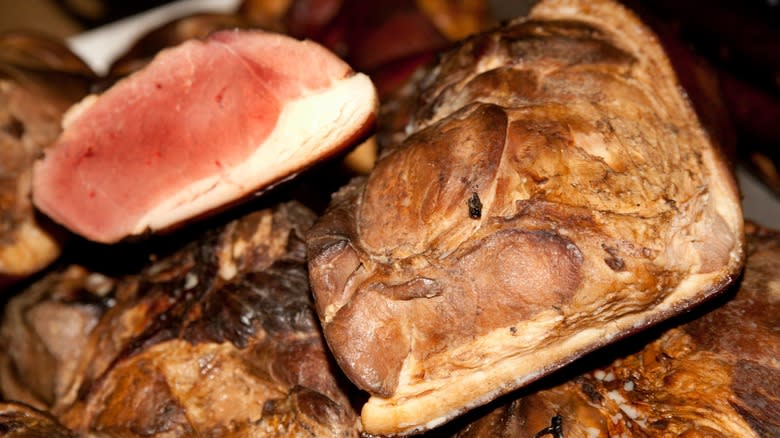Sauna Ham Is The Cured Meat That's Given A Full Spa Treatment

Whether part of a Christmas spread or a lunchtime sandwich, ham is a carnivorous treat that never gets old. First invented in China, the meat curing process has become a central component of an array of global cuisines, especially in Europe -- think the involved process of preparing Spanish jamón ibérico or the salty simplicity of Italian prosciutto. In addition to the infamous renditions in southern Europe, this handy method for storing meats is part of the culinary tradition in Finland, too.
In the Nordic country, ham is prepared using the same practice that local Finnish people enjoy partaking of in their free time -- sitting in a sauna. However, don't expect to spot a leg of ham next to a sweating person; the meat is cooked in a specialized smokehouse. This steamy preparation results in a deeply smoky product with a dark, thick rind. The flavor is salty and balanced, perfect for enjoyment on its own or in simple recipes. Let's dive into what this beloved Finnish food is all about.
Read more: The Best Meat For Your Charcuterie Board Isn't One You'd Expect
What Is Sauna Ham?

Saunapalvikinkku, as the food is known in Finland, combines two of the country's celebrated traditions into one: preserved foods and spa time. The dish is traditionally prepared with pork, although other meats like lamb, venison, and poultry occasionally get the sauna treatment. Prepared in traditional smokehouses -- designated exclusively for food preparation -- it's an artisanal product that is meant to be shared among friends and family.
In Finland's neighboring country, Estonia, sauna ham is especially popular in rural areas, where it's crafted in small quantities. It's seldom sold at grocery stores, and, though it may occasionally be spotted at local farmers markets, most people don't purchase the ham there. Instead, it's passed from hand to hand between neighbors in small villages.
Sauna ham is a dependable preserved meat that can be enjoyed year-round. It's sliced and eaten on its own or pan-fried alongside eggs, a favorite preparation for breakfast. Although less popular than other cured products, sauna ham's smoky, rustic appeal is immediate.
How Is Sauna Ham Made?

Sauna ham is produced under specific conditions that are very different from the dry heat spas celebrated in Finland. Saunas used for curing ham rely on a chamber that is kept so smoky that it eventually creates a layer of black soot on the walls. Before the heat application, the pork undergoes an involved curing process. The preparation ritual is a very old tradition in the Võro community of Estonia and has even been added to UNESCO's Representative List of the Intangible Cultural Heritage of Humanity.
First, the pork is soaked in a saltwater bath for up to a week, which prepares it for curing. Next, the meat is suspended in the smoking chamber in a specific orientation, with the skin facing toward the flame to ensure that a crust develops. The cooking process is not a cold smoke; the pork is heated while it is suspended in the aromatic vapor. The wood used for fuel varies, as does the cooking time, which can last from 10 hours to 3 days. The ham is allowed to cool before being sliced and is then ready to enjoy.
Read the original article on Tasting Table.


